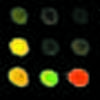 Exploring drug-induced alterations in gene expression in Mycobacterium tuberculosis by microarray hybridization.
Exploring drug-induced alterations in gene expression in Mycobacterium tuberculosis by microarray hybridization.Wilson M, DeRisi J, Kristensen HH, Imboden P, Rane S, Brown PO, Schoolnik GK
Proc Natl Acad Sci U S A. 1999Abstract: Tuberculosis is a chronic infectious disease that is transmitted by cough-propelled droplets that carry the etiologic bacterium, Mycobacterium tuberculosis. Although currently available drugs kill most isolates of M. tuberculosis, strains resistant to each of these have emerged, and multiply resistant strains are increasingly widespread. The growing problem of drug resistance combined with a global incidence of seven million new cases per year underscore the urgent need for new antituberculosis therapies. The recent publication of the complete sequence of the M. tuberculosis genome has made possible, for the first time, a comprehensive genomic approach to the biology of this organism and to the drug discovery process. We used a DNA microarray containing 97% of the ORFs predicted from this sequence to monitor changes in M. tuberculosis gene expression in response to the antituberculous drug isoniazid. Here we show that isoniazid induced several genes that encode proteins physiologically relevant to the drug's mode of action, including an operonic cluster of five genes encoding type II fatty acid synthase enzymes and fbpC, which encodes trehalose dimycolyl transferase. Other genes, not apparently within directly affected biosynthetic pathways, also were induced. These genes, efpA, fadE23, fadE24, and ahpC, likely mediate processes that are linked to the toxic consequences of the drug. Insights gained from this approach may define new drug targets and suggest new methods for identifying compounds that inhibit those targets.
